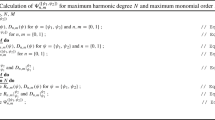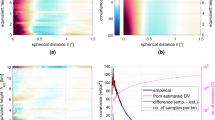Abstract
Spherical harmonic analysis is widely used in all aspects of geoscience. Exact quadrature methods are available for the spherical harmonic analysis of band-limited point values at the grid points of equiangular and Gaussian grids. However, no similarly exact quadrature methods are available for the spherical harmonic analysis of area mean values over the blocks delineated by these grids. In this study, new algorithms appropriate for the exact spherical harmonic analysis of the band-limited area mean values over the blocks delineated by equiangular and Gaussian grids are proposed. For band-limited data, precision that is between that of the least-squares estimation method and of the approximate quadrature methods can be achieved by using the new algorithms. Regarding the computational complexity, fewer operations are needed by the new methods as compared to those needed by the least-squares estimation method and the approximate quadrature methods in the preparation stage when the maximum degree of the spherical harmonic analysis is very large. Simulation experiments are performed to compare the ability to recover the spherical harmonic coefficients by using the least-squares estimation method, the approximate quadrature methods and these new algorithms from aliased data with aliasing components of realistic magnitudes. The results suggest that these new algorithms, with time complexity one order less than that of the least-squares estimation method in the solving stage, perform roughly the same as the least-squares estimation method in recovering spherical harmonic coefficients from the aliased data.






Similar content being viewed by others
Availability of data and materials
The datasets generated and analyzed during the current study are available from the corresponding author on reasonable request.
Code availability
The source code used in this study is written in MATLAB and can be obtained by e-mail upon request.
References
Albertella A, Sacerdote F (1995) Spectral analysis of block averaged data in geopotential global model determination. J Geodesy 70:166–175. https://doi.org/10.1007/BF00943692
Albertella A, Sacerdote F, Sansò F (1993) Geodetic calculus with block-averages observations on the sphere. Surv Geophys 14:395–402. https://doi.org/10.1007/BF00690567
Colombo OL (1981) Numerical methods for harmonic analysis on the sphere. Department of Geodetic Science, The Ohio University, Columbus
Dahlen FA, Tromp J (1998) Theoretical global seismology. Princeton University Press, Princeton
Driscoll JR, Healy DM Jr (1994) Computing Fourier transforms and convolutions on the 2-sphere. Adv Appl Math 15:202–250. https://doi.org/10.1006/aama.1994.1008
Fukushima T (2012a) Numerical computation of spherical harmonics of arbitrary degree and order by extending exponent of floating point numbers. J Geodesy 86:271–285. https://doi.org/10.1007/s00190-011-0519-2
Fukushima T (2012b) Recursive computation of finite difference of associated Legendre functions. J Geodesy 86:745–754. https://doi.org/10.1007/s00190-012-0553-8
Fukushima T (2018) Transformation between surface spherical harmonic expansion of arbitrary high degree and order and double Fourier series on sphere. J Geodesy 92:123–130. https://doi.org/10.1007/s00190-017-1049-3
Gruber T, Reigber C, Schwintzer P (2000) The 1999 GFZ pre-CHAMP high resolution gravity model. In: Schwarz K-P (ed) Geodesy beyond 2000, International Association of Geodesy Symposia, vol 121. Springer. Berlin, Heidelberg, pp 89–95. https://doi.org/10.1007/978-3-642-59742-8_14
Healy DMJ, Hendriks H, Kim PT (1998) Spherical deconvolution. J Multivar Anal 67:1–22. https://doi.org/10.1006/jmva.1998.1757
Heiskanen WA, Moritz H (1967) Physical geodesy. W. H Freeman and Company San Francisco, San Francisco
Jekeli C (1996) Spherical harmonic analysis, aliasing, and filtering. J Geodesy 70:214–223. https://doi.org/10.1007/BF00873702
Jekeli C (2017) Spectral methods in geodesy and geophysics. CRC Press, Boca Raton
Keiner J, Kunis S, Potts D (2009) Using NFFT 3—a software library for various nonequispaced Fast Fourier Transforms. ACM Trans Math Softw 36:1–30. https://doi.org/10.1145/1555386.1555388
Keiner J, Potts D (2008) Fast evaluation of quadrature formulae on the sphere. Math Comput 77:397–419. https://doi.org/10.1090/S0025-5718-07-02029-7
Kunis S, Potts D (2003) Fast spherical Fourier algorithms. J Comput Appl Math 161:75–98. https://doi.org/10.1016/S0377-0427(03)00546-6
Lemoine FG, Kenyon SC, Factor JK, Trimmer RG, Pavlis NK, Chinn DS, Cox CM, Klosko SM, Luthcke SB, Torrence MH, Wang YM, Williamson RG, Pavlis EC, Rapp RH, Olson TR (1998) The development of the joint NASA GSFC and the National Imagery and Mapping Agency (NIMA) geopotential model EGM96. NASA Goddard Space Flight Center, Greenbelt, p 20771
Molodensky SM (1977) The influence of horizontal inhomogeneities in the mantle on the amplitude of tidal oscillations. Izv, Phys Solid Earth 13:77–80
Molodensky SM, Kramer MV (1980) The influence of large-scale horizontal inhomogeneities in the mantle on Earth tides. Izv, Earth Phys 16:1–10
Pail R, Fecher T, Barnes D, Factor JF, Holmes SA, Gruber T, Zingerle P (2017) Short note: the experimental geopotential model XGM2016. J Geodesy 92:443–451. https://doi.org/10.1007/s00190-017-1070-6
Paul MK (1978) Recurrence relations for integrals of associated Legendre functions. Bull Géodés 52:177–190. https://doi.org/10.1007/BF02521771
Pavlis NK (1988) Modeling and estimation of a low degree geopotential model from terrestrial gravity data. Department of Geodetic Science and Surveying, The Ohio State University, Columbus
Pavlis NK, Holmes SA, Kenyon SC, Factor JK (2012) The development and evaluation of the earth gravitational model 2008 (EGM2008). J Geophys Res 117:B04406. https://doi.org/10.1029/2011JB008916
Rexer M, Hirt C (2015) Ultra-high-degree surface spherical harmonic analysis using the Gauss-Legendre and the Driscoll/Healy quadrature theorem and application to planetary topography models of Earth, Mars and Moon. Surv Geophys 36:803–830. https://doi.org/10.1007/s10712-015-9345-z
Rodell M, Houser PR, Jambor U, Gottschalck J, Mitchell K, Meng C-J, Arsenault K, Cosgrove B, Radakovich J, Bosilovich M, Entin JK, Walker JP, Lohmann D, Toll D (2004) The global land data assimilation system. Bull Am Meteor Soc 85:381–394. https://doi.org/10.1175/BAMS-85-3-381
Shebalin JV (1980) The determination of surface harmonic expansion coefficients from mean gravity anomalies by orthogonal collocation. J Geophys Res 85:1809–1813. https://doi.org/10.1029/JB085IB04P01809
Simmons NA, Forte AM, Boschi L, Grand SP (2010) GyPSuM: a joint tomographic model of mantle density and seismic wave speeds. J Geophys Res 115:B12310. https://doi.org/10.1029/2010JB007631
Sneeuw N (1994) Global spherical harmonic analysis by least-squares and numerical quadrature methods in historical perspective. Geophys J Int 118:707–716. https://doi.org/10.1111/j.1365-246X.1994.tb03995.x
Sneeuw N, Bun R (1996) Global spherical harmonic computation by two-dimensional Fourier methods. J Geodesy 70:224–232. https://doi.org/10.1007/BF00873703
Townsend A, Wilber H, Wright GB (2016) Computing with functions in spherical and polar geometries I. The Sphere. Siam J Sci Comput 38:C403–C425. https://doi.org/10.1137/15M1045855
Wahr J, Molenaar M, Bryan F (1998) Time variability of the Earth’s gravity field: hydrological and oceanic effects and their possible detection using GRACE. J Geophys Res 103:30205–30229. https://doi.org/10.1029/98JB02844
Wang R (1994) Effect of rotation and ellipticity on earth tides. Geophys J Int 117:562–565. https://doi.org/10.1111/j.1365-246X.1994.tb03953.x
Wieczorek MA, Meschede M (2018) SHTools: tools for working with spherical harmonics. Geochem Geophys Geosyst 19:2574–2592. https://doi.org/10.1029/2018GC007529
Ye Q-X, Shen Y-H (2005) Practical mathematica handbook. Science Press, Beijing
Acknowledgments
The author appreciates the valuable suggestions of Prof. Zhicai Luo. The author would also like to thank three anonymous reviewers and the editors for their constructive comments and insightful advice, which help improve the work to be more comprehensive and accurate. This work is supported by the National Natural Science Foundation of China (NSFC Grant 41504019).
Funding
This work is supported by the National Natural Science Foundation of China (NSFC Grant 41504019).
Author information
Authors and Affiliations
Contributions
Rong Sun designed the research, performed the research, analyzed the data and wrote the paper.
Corresponding author
Ethics declarations
Conflicts of interest
The author declare that they have no conflicts of interest.
Appendices
Appendix A: Transformation from \({\mathbf{c}}^{\mathbf{^{\prime}}}\) to \(\mathbf{c}\)
The relationship between \({\mathbf{c}}^{{^{\prime}}}\) and \(\mathbf{c}\) can be denoted as:
or written as:
\({\mathbf{M}}_{\mathbf{m}+\mathbf{k}}^{-1}\) can be written as:
with
We denote the vectors \({\mathbf{d}}^{(\mathrm{k})}\) as:
Equation (A7) can be expressed as:
Note that in the first two equations of Equation (A9), only two elements of \({\mathbf{d}}^{(\mathrm{k}+1)}\) are involved. Hence, the multiplication of \({\mathbf{M}}_{\mathbf{m}+\mathbf{k}}^{-1}\) with \({\mathbf{d}}^{(\mathrm{k})}\) can be replaced with four multiplication operations and one subtraction operation. By repeated use of Equation (A9), one can obtain:
Appendix B: Estimation of \({u}_{{l}_{1}m}^{i}\)
According to Eq. (75), the definition of \({u}_{{l}_{1}m}^{i}\) can be given as:
Note that the left side of equation (B1) can be expanded as:
Note that the second equation of (B2) takes advantage of the following equation:
On the right-hand side of equation (B1) \({v}_{{l}_{1}m}^{0}=0\). We find that the following equations satisfy Equation (B1):
In Equation (B4), the number of unknowns \({u}_{{l}_{1}m}^{i}\left(i=\mathrm{0,1},\mathrm{2,3}\cdots ,N-1\right)\) is \(N\) while there are \(\left(N-1\right)\) equations. Consequently, there are an infinite number of solutions for \({u}_{{l}_{1}m}^{i}\left(i=\mathrm{0,1},\mathrm{2,3}\cdots ,N-1\right)\) in Equation (B4). One solution could be:
There are other useful solutions as given below. Note that from Equation (B4), we have:
If \(\left({l}_{1}-m\right)\) is odd, the following equations hold:
From Equation (B4), we have:
If we set \({u}_{{l}_{1}m}^{0}\) to 0, then \({u}_{{l}_{1}m}^{0}={u}_{{l}_{1}m}^{N-1}=0\). Thus, from Equation (B6) and (B7), we have:
If \(\left({l}_{1}-m\right)\) is even, the following equations hold:
From Equation (B4), we have:
If we set \({u}_{{l}_{1}m}^{0}\) to \(1/2\sum_{i=1}^{N-1}{v}_{{l}_{1}m}^{k}\), then \({u}_{{l}_{1}m}^{0}=-{u}_{{l}_{1}m}^{N-1}=1/2\sum_{i=1}^{N-1}{v}_{{l}_{1}m}^{k}\). Thus, from Equations (B6) and (B7), we have:
In summary, if \(\left({l}_{1}-m\right)\) is odd and \({u}_{{l}_{1}m}^{0}=0\), we have:
If \(\left({l}_{1}-m\right)\) is even and \({u}_{{l}_{1}m}^{0}=1/2\sum_{i=1}^{N-1}{v}_{{l}_{1}m}^{k}\), we have:
Suppose \(\mathbf{e}\mathbf{^{\prime}}\) in Eq. (71) can be denoted as:
Then, the following equation can be used to reduce the number of operations if Equations (B16) and (B17) are used to derive the corresponding \({u}_{{l}_{1}m}^{i}\):
Appendix C: Orthogonality and the aliasing-free area of GLQ
The discrete orthogonal equation used in the GLQ method can be written as (Rexer and Hirt 2015; Sneeuw 1994):
where \({\theta }_{i}(i=\mathrm{0,1},\cdots N)\) is the zero value of the Legendre polynomials \({\bar{P}}_{N+\mathrm{1,0}}(\mathrm{cos}\theta )\). Equation (C1) always holds when both \({l}_{1}\) and \({l}_{2}\) are smaller than \(N\). However, when one of \({l}_{1}\) and \({l}_{2}\) is equal to or larger than \(N\), Equation (C1) sometimes holds. This can be proved as shown below.
The product of two associated Legendre functions can be expanded to (Sneeuw 1994):
The associated Legendre functions are orthogonal as:
According to the characteristics of Gauss–Legendre quadrature (Sneeuw 1994; Ye and Shen 2005), as long as \(({l}_{1}+{l}_{2})\) is no larger than \(2N+1\), Gauss–Legendre quadrature can be used to calculate the integral on the left-hand side of equation (C2) exactly:
where \({w}_{{l}_{1}m}^{Q,i}\) are the known quadrature weights. By combining Equations (C1), (C2) and (C3), we have:
with the prerequisite that:
One can see that by replacing \({w}_{{l}_{1}m}^{Q,i}\) in Equation (C4) with \(2\left(2-{\delta }_{m0}\right){w}_{{l}_{1}m}^{GLQ,i}\), we obtain Equation (C1) with the prerequisite given in Equation (C5). Equations (C4) and (C5) are derived here to prove the existence of an ‘aliasing-free area’, as mentioned in Sect. 3.3.
Rights and permissions
About this article
Cite this article
Sun, R. New algorithms for spherical harmonic analysis of area mean values over blocks delineated by equiangular and Gaussian grids. J Geod 95, 47 (2021). https://doi.org/10.1007/s00190-021-01495-8
Received:
Accepted:
Published:
DOI: https://doi.org/10.1007/s00190-021-01495-8




